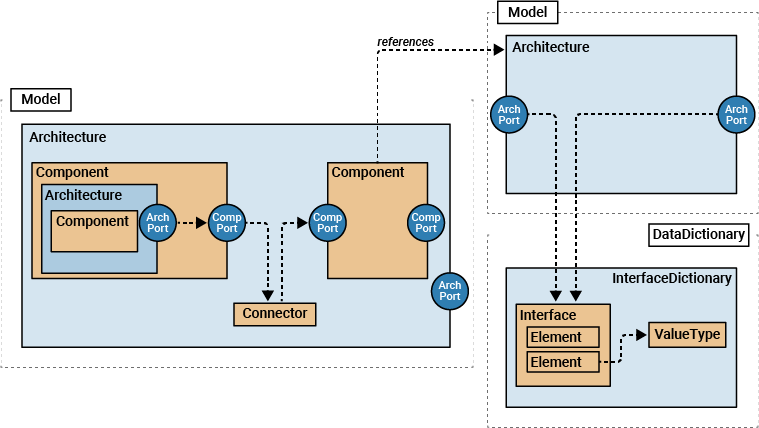System Composer API 概述
System Composer™ 应用程序编程接口 (API) 允许您从 MATLAB® 命令行窗口创建或更改 System Composer 架构模型和链接的工件。将 System Composer API 命令放置在 MATLAB 函数或脚本中,您可以:
通过一个命令执行多个编辑步骤,实现架构模型修改的自动化。
通过生成可作为模板重用并可在以后更改的 System Composer 基础模型,消除重复的架构模型创建步骤。
使用 Simulink® Report Generator™ 生成架构模型和相关工件的专门报告。
System Composer API 由代表架构模型元素的对象组成。例如,API 对象 systemcomposer.arch.Component 和 systemcomposer.arch.Connector 代表 System Composer 模型中的组件和连接器。当您修改 API 对象的可写属性或调用其对象函数之一时,您会影响 System Composer 模型中的相应对象。当您使用 System Composer 模型画布对架构模型中的对象执行操作时,会影响相应的 API 对象。
注意
您无法撤销使用 System Composer API 在 System Composer 模型画布或编辑工具中执行的任何操作。如果您通过 API 执行编辑操作,快速访问工具栏中的撤消和重做按钮将被禁用。
用于模型构建的 System Composer API 对象层次结构
System Composer API 对象按照包含层次结构进行组织。每个架构元素都属于一个根架构。例如,如果组件 A 在 System Composer 模型中包含组件 B,则组件 A 的架构的 API 对象包含组件 B 的架构的 API 对象。
此图显示了 System Composer 模型构建器 API 中的对象层次结构。

该层次结构由多个包含级别组成,这些级别根据深度进行划分:
模型 -
systemcomposer.arch.Model对象是 SLX 文件的表示,该文件存储了关于 System Composer 模型的信息,您可以在该模型中构建您正在设计的系统的架构描述。根架构 - System Composer 模型以一个由
systemcomposer.arch.Architecture对象表示的根架构开始。根位于架构层次结构的顶层。根架构的边界由围绕相关系统的架构端口定义。组件 - 由
systemcomposer.arch.Component对象表示的组件共享 Component 模块的属性和属性。组件是系统中可替换的部分,用于在架构环境中实现明确的函数。组件定义架构元素,例如函数、另一个系统、硬件、软件或其他概念实体。组件也可以是子系统或子函数。架构 - 组件的架构由一个
systemcomposer.arch.Architecture对象表示。System Composer 架构代表由组件组成的系统,以及这些组件在结构上和行为上如何相互关联。端口 - 组件外部存在一个组件端口,由
systemcomposer.arch.ComponentPort对象表示。架构端口存在于组件端口内,当您双击组件时,可以在系统边界上访问,由systemcomposer.arch.ArchitecturePort对象表示。端口是组件或架构上的节点,表示与其环境的交互点。通过端口,信息可以流向其他组件或系统,或者从其他组件或系统流入。连接器 - 由
systemcomposer.arch.Connector对象表示的连接器连接两个端口。连接器是提供端口之间连接的线路。连接器描述信息如何在组件或架构之间流动。数据字典 - 数据字典,由
systemcomposer.interface.Dictionary对象表示,作为模型的一部分或包含接口定义的外部 SLDD 文件存在。数据字典是与您的模型相关的数据存储库。数据字典的“架构数据”部分用于存储在 Simulink 和架构模型接口中使用的共享定义,例如端口接口、数据类型和系统级常量。有关详细信息,请参阅什么是数据字典?数据接口 - 将由
systemcomposer.interface.DataInterface对象表示的数据接口分配给架构模型中的端口。数据接口定义流经端口的信息类型。可以将同一个接口分配给多个端口。数据接口可以是复合接口,这意味着它可以包含描述接口信号属性的数据元素。数据元素 - 进一步明确由
systemcomposer.interface.DataElement对象表示的数据元素的接口。数据元素描述了接口的一部分,如通信消息、计算或测量参数,或该接口的其他分解。值类型 - 值类型,由
systemcomposer.ValueType对象表示,用于明确数据元素,可作为端口分配的接口。值类型可用作端口接口,用于定义流经该端口的原子数据,并具有顶级类型、维度、单位、复杂度、最小值、最大值和描述。